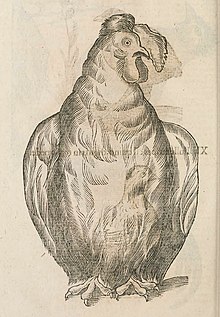


Creeper chickens are characterised by abnormally short legs, so short that the body is carried a few centimetres from the ground. This chondrodystrophy (dwarfism) is caused by a dominant lethal allele, Cp. A number of breeds display the characteristic, among them the Chabo and Jitokku breeds of Japan, the Courte-pattes of France, the Krüper of Germany, the Luttehøns of Denmark, and the Scots Dumpy. They have been called by many names, among them bakies, brevicrews, corlaighs, crawlers, creepers, creepies, dumpfries, dumpies and jumpers.
History
Creeper chickens have been known and described since Renaissance times at least. Chickens of this type were described and illustrated in the Monstrorum Historia of the Bolognese naturalist Ulisse Aldrovandi (1522–1605), published posthumously in 1642 with text by Bartolomeo Ambrosini. In his The Variation of Animals and Plants Under Domestication of 1868, Charles Darwin writes that creeper chickens were among the types described in a Chinese encyclopaedia compiled from earlier sources and published in 1596.
They have been called by many names, among them bakies, brevicrews, corlaighs, crawlers, creepers, creepies, dumpfries, dumpies and jumpers.
The creeper gene was described by Ira Eugene Cutler in 1925, and confirmed by Walter Landauer and L.C. Dunn in 1930. The symbol Cp was assigned to it by Frederick Hutt in 1933. It was shown to be present in the Chabo by Landauer in 1942, in the Jitokko by S. Okamoto in the same year, and in the Gan-Dori and Miyaji-Dori by Tohru Shibuya in 1972.
Biology
The short legs of creeper chickens are the result of autosomal dominant transmission of a lethal allele, Cp. Affected birds are heterozygous (Cp/+) for the gene; homozygotes (Cp/Cp) die at the embryo stage. The Cp trait is linked closely to the gene for the rose comb, MNR2.
Shortening of the leg bones is also observed in Indian Game, and some birds carry a lethal allele. It is quite different to that of the creeper; Hutt assigned it the symbol Cl.
References
- ^ F.B. Hutt (1949). Genetics of the Fowl. New York: McGraw-Hill Book Company.
- ^ Janet Vorwald Dohner (2001). The Encyclopedia of Historic and Endangered Livestock and Poultry Breeds. New Haven, Connecticut; London: Yale University Press. ISBN 0300088809.
- Scots Dumpy / United Kingdom (Chicken). Domestic Animal Diversity Information System of the Food and Agriculture Organization of the United Nations. Accessed December 2019.
- Ulisse Aldrovandi (1642). Ulyssis Aldrovandi patricii Bononiensis Monstrorum historia: cum Paralipomenis historiae omnium animalium ... (in Latin). Bononiae: Typis Nicolai Tebaldini.
- ^ Charles Darwin (1868). The Variation of Animals and Plants Under Domestication. London: John Murray.
- ^ Ira Eugene Cutler (October 1925). Reptilian Fowls: A Study in Atavistic Heredity. Journal of Heredity. 16 (10): 353–356. doi:10.1093/oxfordjournals.jhered.a102511. (subscription required).
- Walter Landauer, L.C. Dunn (1930). Studies on the creeper fowl. Journal of Genetics. 23 (3): 397–413.
- F.B. Hutt (1933). Genetics of the Fowl. II. a Four-Gene Autosomal Linkage Group. Genetics. 18 (1): 82–94. doi:10.1093/genetics/18.1.82.
- Walter Landauer (1942). Studies on the Creeper Fowl. XIV. The Japanese Bantam Fowl. The American Naturalist. 76 (764): 308–317. doi:10.1086/281045. (subscription required).
- Tohru Shibuya, Yoshihisa Fujio, Kyoji Kondo (1972). Studies on the action of Creeper gene in Japanese chicken. The Japanese Journal of Genetics. 47 (1): 23–32. doi:10.1266/jjg.47.23.
- ^ Keiji Kinoshita, Takayuki Suzuki, Manabu Koike, Chizuko Nishida, Aki Koike, Mitsuo Nunome, Takeo Uemura, Kenji Ichiyanagi, Yoichi Matsuda (2020). Combined deletions of IHH and NHEJ1 cause chondrodystrophy and embryonic lethality in the Creeper chicken. Communications Biology. 3: article 144. doi:10.1038/s42003-020-0870-z.
- Greg Davies (December 2016). About the Creeper Gene. Aviculture Europe. 12 (5), article 10. Archived 9 November 2022.